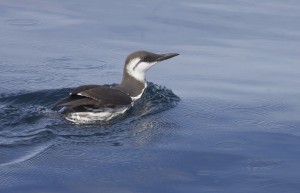
Kodiak Island residents have been reporting a large number of common murres washing up dead on local beaches.
Kodiak National Wildlife Refuge bird biologist, Robin Corcoran, says that the common murre is a small, black and white seabird and that its breeding colonies are more common in the Alaska Peninsula and in the Aleutians.
“They do spend some time here in the winter and then there’s a handful of small breeding colonies primarily along the east of Kodiak Island – we’re talking less than 200 birds – but we do have a population of sort of non-breeders. Birds that… [it] takes several years for these birds to reach maturity and return to the colonies to breed and we seem to have quite a few that just hang out.”
She says the Refuge first started getting reports in April and May of a handful of murre die-offs.
“They were showing up in places where people don’t normally see them. These are birds that are usually pretty far off shore. So, we were getting all these reports of them being seen close to shore, foraging, trying to find forage fish to feed on in the near-shore, and then we were getting an occasional report of a dead bird, but starting in late August, we were getting to see more and more dead birds.”
She says some beaches have a large number of carcasses. She says there are over 100 in Pasgashack.
“I went out to Pasagshack last week and visited a couple of other beaches – fossil beach and then another beach closer to berry lagoon – and found a couple of dozen birds on each one kilometer stretch of beach I visited. And fossil beach had several dead murres even though it’s a very small beach.”
She says it’s unclear what could have caused the deaths, but it could be related to the birds’ inability to catch forage fish.
“Right now they’re going through a wing feather molt, so they’re losing their flight feathers. Their primaries and secondaries, so it’s long wing feathers. And they spend about 70 days where they can’t fly, and so the die-off seems to coincide with this flight feather molt where they’re flightless and it might be that they don’t have the mobility to move to locations where they can find the forage fish. And they’re already in these unusual locations to begin with.”
And why they went to those places? That’s also unknown.
“There have been some colony abandonment in other areas, so there’s a possibility that they came from these colonies. There’s certainly a tremendous number more than we had when we surveyed Afognak in 2012. This is not an exaggeration: In August of 2012, on Afognak on the transect that we surveyed. This year, same transect, we saw over 5,000 murres.”
Corcoran says 2012 was also the last year they saw a major bird die-off, that time of both murres and grebes in January through March. They collected carcasses and sent them to the National Wildlife Health center in Madison, Wisconsin, where they ruled that starvation was the cause of death.
“The birds that we’ve sent this year, they’ve just been able to do a preliminary analysis, but it does look like the birds are emaciated, which means they don’t have any fat on their bodies, and they don’t have any food in their digestive systems, which indicates that they starved. They’re going to run additional tests, so the final analysis isn’t in, but right now it does look like it’s related to the forage fish situation.”
She says it could be connected to the whale die-offs, and they’ll be considering environmental factors.
“They’re looking into the possibility of harmful algal blooms. I know they’re going to test for the toxins that are related to parasitic shellfish poisoning, like domoic acid and saxitoxin. I know those tests will be run. It could be related to the warm ocean temperatures having an impact on forage fish populations. On the types of forage fish or the quality of the forage fish, or even the locations – where they can find the forage fish.”
Corcoran says the Refuge’s survey data has also indicated that several other bird species’ numbers have declined, like the pigeon guillemot and the marbled murrelet. And she says she’s read about the die-off reaching Homer, as well as along the Alaskan Peninsula and into the Aleutians.
Kayla Deroches is a reporter at KMXT in Kodiak.




